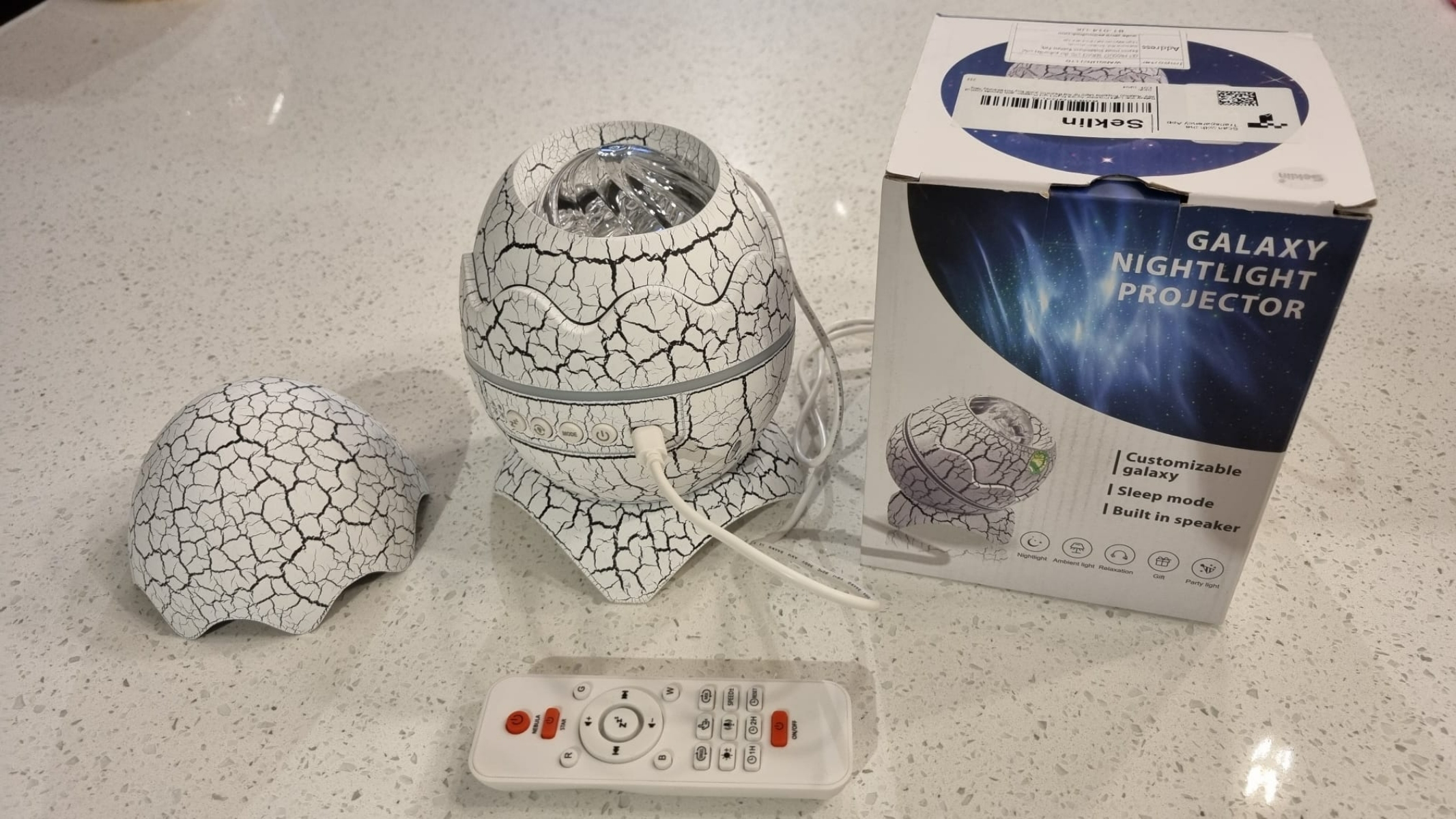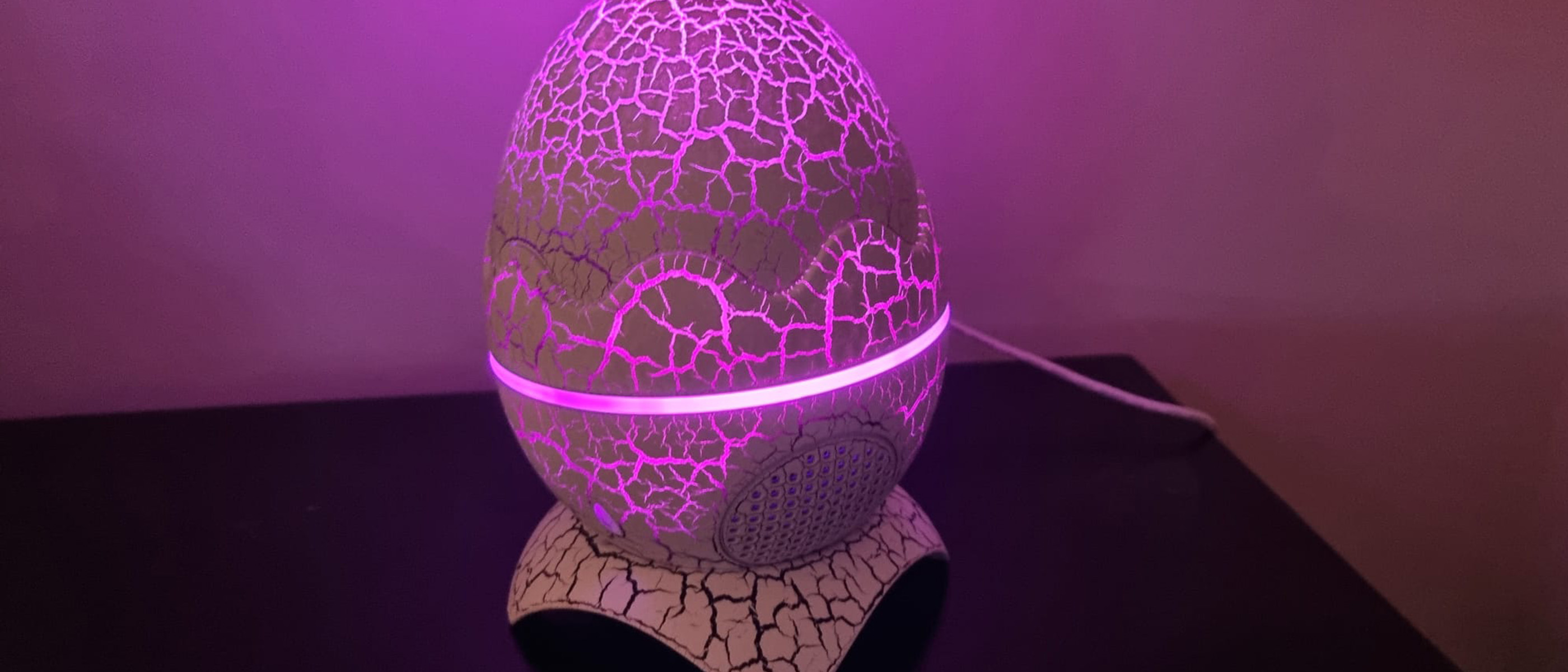Live Science Verdict
A reasonably priced multi-functional projector — a nightlight, projector, Bluetooth speaker and white noise sound system all in one.
Pros
- +
Multifunctional
- +
Novelty design
- +
Reasonably priced
Cons
- -
Geared towards younger children
- -
Some safety features missing
- -
Difficult to control in the dark
Why you can trust Live Science
This multifunctional dinosaur egg galaxy star projector would appeal to young users interested in paleontology and space. It can be a galaxy projector, a nightlight, a speaker, and a white noise comforter.
Size: 170 x 150 x 140 mm
Bulb Type: LED
Laser: Not specified, likely class two
Control: Button or remote control
Rotation: Yes
Sleep timer: Yes
Speaker: Yes
Projection Surface: 20-80 square meters
This projector is marketed as each of the above, but with so many companies online offering the same model under a different guise, we questioned its integrity. The model we purchased came from a company called 'Seklin,' but the only indication of this when the model arrived was a sticker on the box; we assume that this would be the same when you order from other 'brands', especially from marketplaces like Amazon.
No matter who you end up buying it from though, the Dinosaur Egg Galaxy Projector is a surprisingly capable projector with a novelty design that young kids and dinosaur fans will love. It might not have the scientific accuracy or features of the best star projectors, but we think it's still a cracking choice.
Dinosaur Egg Galaxy Star Projector: Design

- Novelty design, appropriate for a child's room
- Detachable base/stand
- Solid build quality
The dinosaur egg galaxy star projector comes packaged in a suitably sized cardboard box and held securely in place. The egg we received is white with black lines on, but there are alternative color options available depending on which retailer you go to. The version we found on Walmart had five color options on offer.
The box isn't particularly flashy — often the case with star projectors, we've found— it simply has an image of the projector and some text describing situations it could possibly be used in; relaxation, a starlit dinner, and use in a games room.
The novelty design is appealing to children, though an egg-shaped star projector isn't a typical choice for such a device. That said, it will appeal to young paleontology fans as well as space enthusiasts.
The design resembles a cracking dinosaur egg with the lights shining through the cracks. When the top of the 'egg' is removed, the LEDs project bright-colored patterns on the ceiling. When the top of the egg is attached, the light can still be seen through the cracks to transform the projector into a nightlight — the desired color is easily selected on the remote.
The egg sits on a stand in the same hatching egg pattern — we would have preferred it to be plain so it looks like an egg on a stand, rather than incorporating the base design, but we're splitting hairs here. It provides a good level of stability and it feels secure. When in the stand, the egg can be tilted to project the light at any angle you choose (apart from down, obviously). The device feels well made, and the lens is made of tough plastic so doesn't flex or bend.
The stars and nebula are bright and the colors are rich in a darkened room within a few meters of the projector. At further distances, the nebula color becomes weaker but the stars remain bright. There is a range of light color combinations for personal tastes and the projector will appeal to all genders.
The egg has four buttons on its body, located next to the power port. In our opinion, the power lead would be better positioned on the bottom of the egg, through the stand; this would also save space and allow you to place the egg on a narrower shelf.
Dinosaur Egg Galaxy Star Projector: Performance

- Nebula looks more like water
- Tinny speaker, lacking bass
- Effective as a projector and a night light
On powering up, the 'voice' when switching the projector on is a little tricky to distinguish, but we deciphered that it says 'Bluetooth mode.' It is unnecessary to link the device to Bluetooth to see the light as it turns on as soon as you turn the power on. Bluetooth is only required to stream music through the built-in speaker. Pairing the device to our Android phone was easy using the phone's Bluetooth search setting (the pairing code is supplied in the manual). We used our phone's music app to play a song instantaneously through the speaker.
We liked the idea of having an integrated speaker to play music and sounds alongside the light display, adding another element of ambiance to the room. We tested it in a child's bedroom and found it effective as a calming device at a low volume. At higher volumes — as expected for an integrated speaker in a product that sits at this price point — the speaker lacks bass and is tinny. We wouldn't recommend using this as the primary music source if you plan for the sound to fill a large room or work over the noise of people chatting. You can also use the speaker without having the light and laser turned on, perhaps helpful in reading aloud an audiobook where the sound quality and bass levels aren't essential.
When not playing sounds or music, the projector's motor is very quiet when rotating and cycling through the lights, we could hardly hear it at all, making it perfect for relaxation.
The projector has a musical rhythm mode, changing the color of the nebula and the speed at which the stars flash in time to the music. It's pretty effective but tends to flash between colors quite quickly, even with slower-paced music.
The somewhat unique white noise functionality plays from a catalog of 19 different sounds; some are a little hard to distinguish or a bit leftfield to use as sleeping aids. We could make out robot noises, a cow mooing, a dog barking, and birdsong alongside a variety of more sleep-appropriate 'watery' noises, radio fuzz (standard white noise), and piano tunes.
When switched on, the default sequence cycles through four different color combinations of nebulae, with the stars 'breathing' on or off. The nebulae displays are softly moving waves of light and do not have the depth or texture that some other projectors (such as the BlissLights Evolve) have. Using the remote, you can select dual color mode which offers many different color combinations (two or three colors at once). You can choose to have the stars and the nebula turned on independently or both together.
A common feature in novelty projectors is the green laser stars; they are randomized in their location rather than rigid lines and are pretty bright. The 'class' of laser should be class one or two in line with other star projectors and safety regulations, but this isn't specified and there is no laser warning label. We recommend pointing the laser out of the line of sight so you don't accidentally look into the beam.
The coverage area (specified as 20 - 80 square meters) is suitable for a child's room, though the stars cover a much wider surface area than the nebula projection.
Dinosaur Egg Galaxy Star Projector: Functionality

- Remote control to access all functionality
- Sleep timer and automatic shut off
- Powered with USB-C
As the primary means of control, the supplied remote lets you customize more functions, including ambient lights, nebula and star adjustments, volume, song selection, and rhythm mode. It takes two AAA batteries (not supplied). We recommend keeping the remote out of the reach of small children as the battery compartment does not feature a child-safe screw.
The instruction manual clearly details the functionality of the remote and the buttons on the egg; make sure you have your reading glasses as the numbers on the picture in the manual are tiny! You will need to learn which buttons do what as they are not illuminated on either the egg or the remote, so almost impossible to see in the dark — we think illuminated buttons would be a nice touch to add to make operation easier.
There is a choice of two sleep timers, one hour or two hours, set using the remote. On selecting the timer, the egg beeps and flashes. Once set, there are no indications that it is running until the egg turns off. As a safety precaution, it turns itself off after four hours. We left the projector on for this length of time and we are pleased that it doesn’t get hot while in use.
The projector is powered by a USB-C to USB power cable of 1.5 meters (supplied), allowing you to position the projector on a shelf or work surface easily; this is much more of a generous length than the astronaut galaxy star projector which we reviewed before this model.
Should I buy the Dinosaur Egg Galaxy Star Projector?

Upon receipt of the projector, our young child's interest was immediately piqued — dinosaurs and space, wow! The design is well suited to a child's bedroom (and conveniently matches our existing décor) or a dinosaur enthusiast's office space. The USB-C cable can be plugged into any USB port so that you can power it from a power bank or laptop as well as mains.
The nebula colors are relaxing, although not realistic or scientific in their movement. Our children still enjoyed them vocalizing their interest with 'ooohh's' of delight.
For a low-cost novelty projector, the Galaxy Nightlight Projector ticks many boxes; we were surprised at the price, which hovers at $25; we'd happily pay a little more than that for what is a neat little multi-functional device. It would make a lovely reasonably-priced gift that will definitely be treasured by a child.
If the Dinosaur Egg Galaxy Star Projector isn’t for you
An alternative novelty projector would be the Astronaut Starry Sky Projector. Like the Dinosaur Egg Galaxy Star Projector, it is a surprisingly good build quality but offers a better, more vivid nebula display, in our opinion.
The BlissLights Evolve, which we also reviewed recently, is perhaps more suitable if you're looking for a gift to give to older children or adults. It is spherical so offers the same positioning flexibility, and can be controlled using an app (rather than a remote). It features color-blending technology to give the nebulas more texture and character. It can also be turned on and off using Alexa or Google Assistant and there's a choice of model with either blue, green or no lasers.
If it's a scientific star projector that you're looking for, like with many novelty-shaped projectors, the Dinosaur Egg Galaxy Projector shouldn't be on your options list. We would always recommend considering the Sega Toys Homestar Flux, the National Geographic Astro Planetarium Star Projector, or the Bresser Junior Astro-Planetarium Deluxe if your preferred choice is an educational learning device.

Tantse Walter is a photographer and adventurer that's spent seven years facilitating global adventurous expeditions. She loves getting into the nitty-gritty of sourcing and planning trips. Whether that be for astrophotography location scouting, or just for the love of exploration. Tantse enjoys taking creative, bright and bold photos of people, places, animals and the night sky. She is currently a contributing writer to both Space.com and LiveScience.com.











